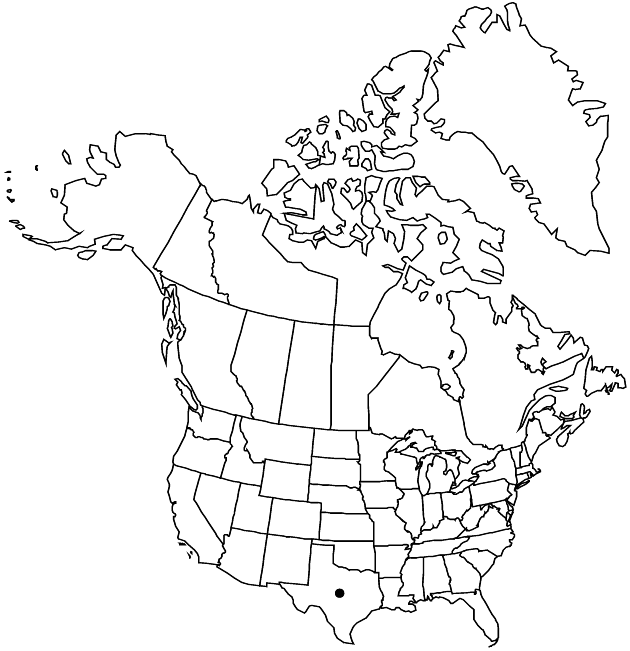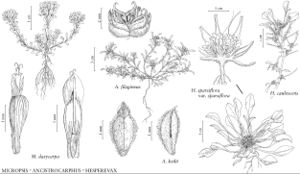Difference between revisions of "Micropsis dasycarpa"
Bull. Soc. Bot. Genève, sér. 2, 5: 224. 1913.
Common names: Bighead straitjackets
IntroducedIllustrated
Basionym: Filago dasycarpa Grisebach Abh. Königl. Ges. Wiss. Göttingen 24: 185. 1879
FNA>Volume Importer |
imported>Volume Importer |
||
| Line 8: | Line 8: | ||
}} | }} | ||
|common_names=Bighead straitjackets | |common_names=Bighead straitjackets | ||
| + | |special_status={{Treatment/ID/Special_status | ||
| + | |code=I | ||
| + | |label=Introduced | ||
| + | }}{{Treatment/ID/Special_status | ||
| + | |code=F | ||
| + | |label=Illustrated | ||
| + | }} | ||
|basionyms={{Treatment/ID/Basionym | |basionyms={{Treatment/ID/Basionym | ||
|name=Filago dasycarpa | |name=Filago dasycarpa | ||
| Line 30: | Line 37: | ||
|elevation=± 20 m | |elevation=± 20 m | ||
|distribution=Tex.;se South America. | |distribution=Tex.;se South America. | ||
| + | |introduced=true | ||
|discussion=<p><i>Micropsis dasycarpa</i> is known in the flora area from one gathering (Victoria County, Gulf Coast prairie with Mimosa strigillosa Torrey & A. Gray, in 1987). For this treatment, I have assumed the Texas population to be a recent introduction; R. Barneby provided evidence that <i>M. dasycarpa</i> could be an overlooked amphitropical native (J. D. Morefield 2004; see also discussion under 101. <i>Psilocarphus</i>).</p> | |discussion=<p><i>Micropsis dasycarpa</i> is known in the flora area from one gathering (Victoria County, Gulf Coast prairie with Mimosa strigillosa Torrey & A. Gray, in 1987). For this treatment, I have assumed the Texas population to be a recent introduction; R. Barneby provided evidence that <i>M. dasycarpa</i> could be an overlooked amphitropical native (J. D. Morefield 2004; see also discussion under 101. <i>Psilocarphus</i>).</p> | ||
|tables= | |tables= | ||
| Line 53: | Line 61: | ||
|publication title=Bull. Soc. Bot. Genève, sér. | |publication title=Bull. Soc. Bot. Genève, sér. | ||
|publication year=1913 | |publication year=1913 | ||
| − | |special status= | + | |special status=Introduced;Illustrated |
| − | |source xml=https:// | + | |source xml=https://bibilujan@bitbucket.org/aafc-mbb/fna-data-curation.git/src/bb6b7e3a7de7d3b7888a1ad48c7fd8f5c722d8d6/coarse_grained_fna_xml/V19-20-21/V19_775.xml |
|tribe=Asteraceae tribe Gnaphalieae | |tribe=Asteraceae tribe Gnaphalieae | ||
|genus=Micropsis | |genus=Micropsis | ||
Revision as of 21:40, 27 May 2020
Plants mostly 5–8 cm. Leaves 6–9 × 2–4 mm. Heads congested distally, mostly 4–5 mm. Bisexual corollas: lobes usually 4.
Phenology: Flowering and fruiting Mar–May.
Habitat: Drying mud at edge of pool
Elevation: ± 20 m
Distribution

Introduced; Tex., se South America.
Discussion
Micropsis dasycarpa is known in the flora area from one gathering (Victoria County, Gulf Coast prairie with Mimosa strigillosa Torrey & A. Gray, in 1987). For this treatment, I have assumed the Texas population to be a recent introduction; R. Barneby provided evidence that M. dasycarpa could be an overlooked amphitropical native (J. D. Morefield 2004; see also discussion under 101. Psilocarphus).
Selected References
None.
Lower Taxa
None.
